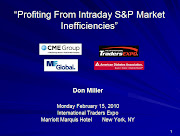Game Within a Game - Events of the last few months -- including both personal performance (that had me attaining a "career" annual goal in three quarters) and increasingly erratic market conditions -- have caused me to think very carefully about how I approach the remaining three months of this journey. In addition, my still-evolving poker skills are telling me to balance (1) protecting the chips accumulated during the first three legs of this year's race with (2) not simply mailing it in or coasting to the finish in the fourth and final leg.
Such is the reason for the stretch goal that I first referenced in my September 23 special post. And such is the reason as I mentioned in last night's video that I've now added a new element to "score" the final quarter of this 2008 game to complete the year, which is to "count down" the amount remaining to attain my incremental "stretch" target of a $250K bonus. I think this best balances the two goals of balancing chip protection with a continued and sustained "fight to the finish". To that extent, I've added a percentage indicator to the left which will help me track my attainment of this bonus.
I think balancing chip protection with sustained performance is tricky at best, yet it's a required balance. Going back to the poker world for the moment, the story of Archie Karas hits home hard. If you're not familiar with his story, Archie once accumulated over $40 Million playing pool, poker and dice -- reaching the top of the gaming world -- only to lose it ALL back in a short period of time. Watching this year's televised World Series of Poker is another analogy where several huge (and inexperienced) chip leaders are giving it all away in a matter of hours.
So I'm not going there. $1 Million may not be $40 Million, but $1 Million can be zero just as quickly. Suffice it to say that I'm essentially viewing this last quarter as I would at a cash (non-tournament) poker game, which is locking up the chips that were accumulated during the first three quarters, and free-rolling the final quarter with no increase in trading size while managing risk carefully in this market that continues to see 10-20 point ES swings in the blink of an eye.
 Q1-Q3 Chip Management Evaluation - I need to be careful with this one, because the final chip count still doesn't occur until 12/31/08 and I still avoid looking at the equity balance. Yet as I'm viewing the final three months as its own "game", I think I'm a bit safer in evaluating my YTD performance over the first three quarters without it negatively affecting my future performance. To that extent, I've attached a 2008 monthly "chip stack" chart that reflects how I book my results. (And for those new to this blog, yes the data is 100% real and I'd stake my industry & CME reputation on it, so let's not go there.) You can click on the chart to enlarge.
Q1-Q3 Chip Management Evaluation - I need to be careful with this one, because the final chip count still doesn't occur until 12/31/08 and I still avoid looking at the equity balance. Yet as I'm viewing the final three months as its own "game", I think I'm a bit safer in evaluating my YTD performance over the first three quarters without it negatively affecting my future performance. To that extent, I've attached a 2008 monthly "chip stack" chart that reflects how I book my results. (And for those new to this blog, yes the data is 100% real and I'd stake my industry & CME reputation on it, so let's not go there.) You can click on the chart to enlarge.Here's what the chip stacks reflect. Each month has four stacks:
The first light green stack reflects accumulated daily gains before commissions. So for example, if the day's gross gain is net positive after adding all trades (+ or -), it gets recorded there and is included in the stack.
The second red (negative) stack reflects accumulated daily losses before commissions. Essentially the reverse of above.
The third (negative) orange stack reflects commission costs.
The fourth (negative and barely viewable) yellow stack reflects overhead costs including seat lease and data feed costs.
And the final bright green stack reflects the net result of the first four.
I think the best way to evaluate whether chip management has been acceptable is to compare the first and second daily gain vs. loss stacks, which going back to responses to comments several weeks ago, essentially reflects the only win/loss ratio I ever look at since I view each day's activity as a single trade.
I suppose one embedded concept worth noting is that I view daily losses -- when they do occur as they will -- as anticipated and necessary business expenses just like any other expense such as commissions and business overheads. Another concept is just as I view each day as its own "trade", I also view each month as its own larger "trade", meaning it's mentally closed, is written in stone and can't be undone, yet has zero impact on the next month.
Feel free to share your comments & observations. I still firmly believe it's better to look forward than backwards, and that's where the focus remains.
The counter says we have 88 days to look forward to.
Enjoy the rest of your weekend.
















7 comments:
Boy, those are beautiful graphics... nice contrast, bright colours... :)
But they nice chart pales in comparison with the beautiful numbers: impressive!
A source of inspiration! Thanks, Don.
Awesome job Don! I hope the
Sox finish as well as you.
Best
Tom
You did a great job, especially in September!
another great post; I hope readers realize the tremendous value you offer here. you consistently share insights about your business, from the point of view of the pro trader. to me, that is much more useful than trying to figure out what Stoch settings you use of if you like the MACD better than RSI.
it reminds me of pro sports, specifically football. I constantly hear quarterbacks and their coaches stress the importance of a short memory - be quick to forget the INT in the endzone or the pass into the stands. be done with it, look ahead, and move forward.
so when i read a pro trader writing that he views a day as a single trade and same for a month, that's something i should probably pay attention to. each trader will have to find/develop his own edge and style. seeing how a pro thinks during and about the game can help other traders strengthen their own games.
kudos on your blog and much continued success to you on your journey.
take care -
derek
Thanks all ... so long as we keep in mind what's past is past, we can hopefully keep our eyes on the road ahead.
Derek - Absolutely. I definitely agree and indeed view trading as a competitive endeavor with many parallels to sports ... especially from a psyche perspective. Interceptions, blown saves, hitting one into the woods, mental lapses ... they're all about accepting less than perfection while minimizing damage -- both immediate and longer term.
Welcome to the blog.
Don
First of all congratulations Don. Secondly, what a courage to share your results with us. Thanks.
Last but not least, can you please share the set-ups you usually use (I follow your blog pretty regularly and know that you mention your trades but I'm suggesting to have couple blog entries explaining the set-ups you like) Just a suggestion.
Hi Mertto -
I typically trade various sequences during the day, in part providing liquidity as a member of the Merc.
There are many to choose from, but I primarily look for brief high probability & unsustainable emotional pullbacks or overextensions, and take the trade off as the market reverts toward its trend support (for overreactions) or resumes its trend (for pullbacks).
Trend indicators such as MAs & ADX on multiple timeframes, as well as +1000ish or -1000ish TICK help to gauge overextensions or TICK retracements to 0 to gauge pullbacks, and the 15-min VIX helps gauge the general environment (uptrending short biased; downtrending long biased) so long as its confirmed by the other indicators.
Hope that helps.
Don
Post a Comment